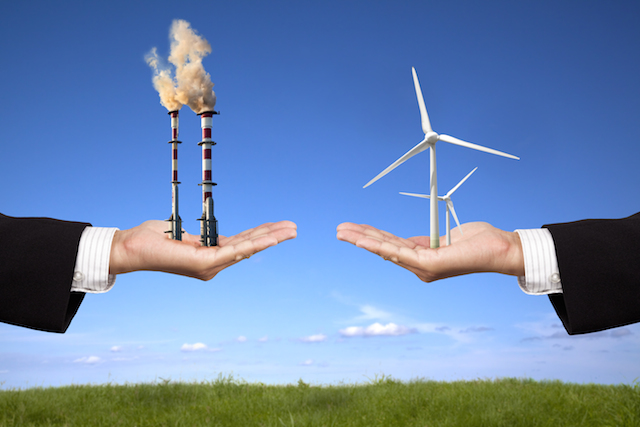
Pollution and clean energy photo via Shutterstock
By Margaret Barthel
The outlook on climate change is pretty gloomy: there’s the National Climate Assessment study that warned of impending greenhouse-gas driven disaster in the US. Then there’s the recent fervor over sea-level rise affecting iconic national monuments. And, as always, the clincher is the fact that some people still believe that the science behind the phenomenon is a matter of opinion.
It looks unlikely that Congress, divided as it is, will move forward with legislating any substantial climate change policies in the near future. That may be the melted icing on top of the soon-to-be-several-degrees-toastier cake, but what is heartening is that some states are stepping up to fill the leadership void on climate change, pioneering new policy models and working together to curb emissions and build up sustainable infrastructure.
Massachusetts has been working away steadily on climate change for a while. Governor Deval Patrick touted his state’s recent progress in an excerpt from his commencement address at UMass printed in the Metrowest Daily News this week. The state has gone from 3 megawatts to 500 megawatts of solar energy capacity, and 3 megawatts to 100 megawatts of land-based wind capacity, which doesn’t include the Cape Wind project currently in the works. Coal energy use hovered at 3 percent as of 2012, down from 18 percent 12 years earlier, and total greenhouse gas emissions are now 16 percent under what they were in 1990. Additionally, Patrick wrote that Massachusetts has “tripled the energy we’re saving from efficiency initiatives and today lead[s] the nation in energy efficiency and greenhouse gas reduction targets.”
Those numbers are promising, but Patrick wants to keep the momentum going, continuing to encourage wind and solar power infrastructure construction, overseeing the shutdown of the remaining two coal power plants in the state, and pushing energy efficiency. Patrick also identified natural gas as an “imperfect choice but best of the fossil fuels,” a viable transition fuel for Massachusetts as it plunges forward into the green future, provided that the state can manage environmental impacts of natural gas pipelines.
California–currently home to record-breaking droughts and accompanying “firenados”–is arguably Massachusetts’ competitor in terms of the scope of its climate change actions (and, it’s worth noting that California’s size and population mean it has influence on the national stage and make it a realistic scale model for national climate change efforts in the future). When the state enacted tough vehicle emissions standards, for instance, national car manufacturers, not wanting to lose the business of Californians, were forced to acquiesce. Governor Jerry Brown’s leadership has also been an important factor; last week, he met with governors from Washington, Oregon, and British Columbia to discuss a regional cap-and-trade initiative (much like the Regional Greenhouse Gas Initiative on the East Coast). Brown has also urged leaders in China and Mexico to join him in curbing emissions. The state intends to reduce emissions to 1990 levels by 2020. Twenty-three percent of the state’s electricity comes from renewable energy sources.
Last week, Washington state started down the path to building a serious state-driven response to climate change, too. Governor Jay Inslee issued an executive order that mandated a group to begin work on a cap-and-market program that would put the state back on track to arrive at its emissions goals. Inslee also directed his state government to work to phase out coal power, implement clean transportation systems, build renewable energy infrastructure, increase energy efficiency in existing buildings, and slash the carbon footprint of the state government.
Massachusetts’, California’s, and Washington’s state climate action plans haven’t solved climate change, but the legislation has gotten closer than any of the dog and pony shows in DC to reducing emissions and restructuring infrastructure to meet the coming challenge. Not a bad reminder to hold a little closer as the future sounds more and more apocalyptic with each new scientific study.
 About the Writer
About the Writer
Margaret Barthel recently graduated from Smith College with a degree in English Language and Literature. Among other things, she’s a writer, reader, history buff, and outdoors enthusiast with deep interests in feminism, politics, and the environment. A semester abroad studying at Oxford University and exploring continental Europe, in addition to plenty of quirky family vacations, are to blame for her love of travel. Find more of her work at margaretbarthel.wordpress.com.


